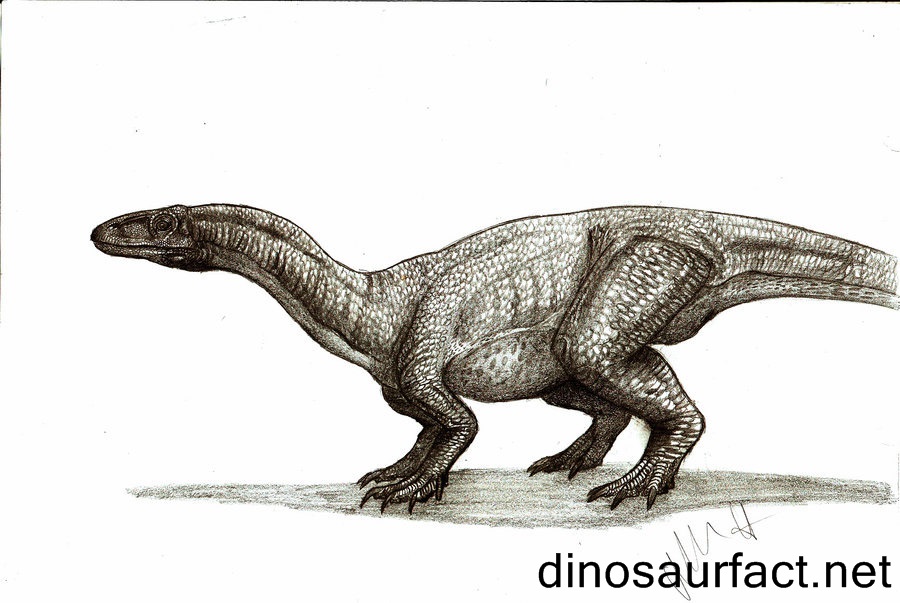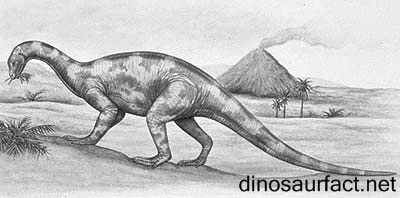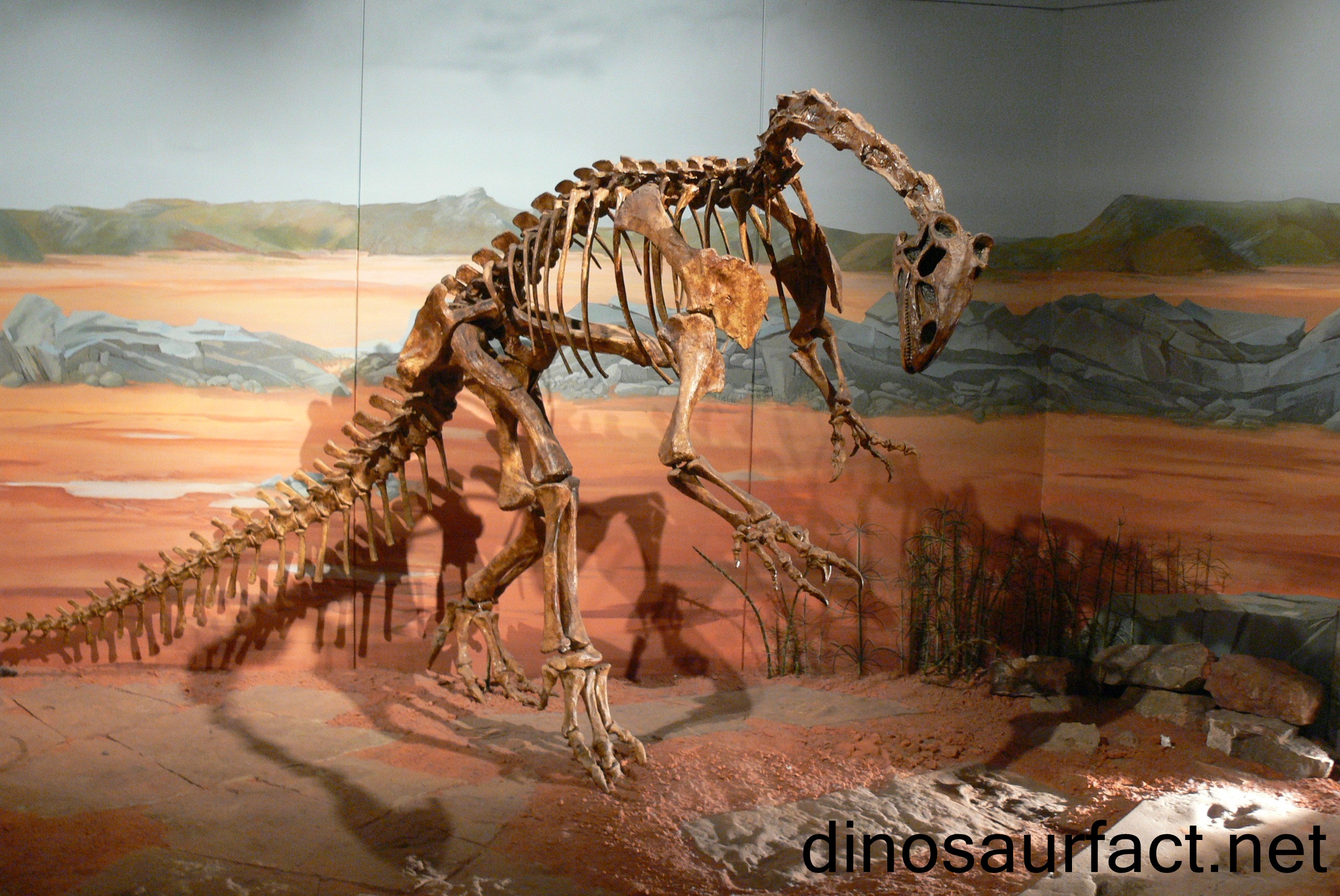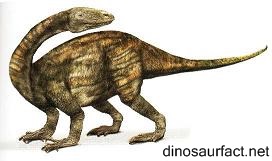 Click to visit the previous dinosaur bio
Click to visit the previous dinosaur bio
 |
|
 |
|
Kingdom: Animalia
Phylum: Chordata
Class: Sauropsida
Superorder: Dinosauria
Order: Saurischia
Suborder: Sauropodomorpha
Family: Thecodontosauridae
Genus: Thecodontosaurus
 |
|
 |
|
 |
|

The Thecodontosaurus was one of the first dinosaurs to be discovered by man. In fact, its fossils were discovered even before clade ‘Dinosauria’ was defined properly by paleontologists. When found first, the remains of the Thecodontosaurus were thought to be those of a scaled reptile belonging to order ‘Squamata’. They were later recognized as those of a dinosaur after scientists delineated ‘Dinosauria’ in detail in the year 1942.
The Thecodontosaurus was found in Bristol, England. It lived in the Norian to the Rhaetian age of the Triassic period. The time frame of its existence is judged at 212 to 205 million years ago. It was a small to moderate sized dinosaur as compared to its contemporaries, growing to an adult size of 7 to 8 feet in length.
Based on the characters of its bones, the Thecodontosaurus is classified as a primitive sauropodomorph. It was an herbivorous dinosaur, like most other early sauropods. It walked on its hind legs. Dinosaurs like the Thecodontosaurus gave rise to the huge quadruped sauropods of the Jurassic period.
The Thecodontosaurus was named so due the distinctive characteristics of its teeth.
Nomenclature
- The words ‘thec’ and ‘odonto’ are derived from the Greek words ‘theke’ and ‘odous’. They translate to ‘hollow or socket’ and ‘tooth’ respectively. The word ‘sauros’ means lizard in Greek. Thus the name ‘thecodontosaurus’ roughly means ‘lizard with teeth in sockets’.
- The teeth of the Thecodontosaurus were not embedded directly in the mandible like other reptiles. They were present in hollow cavities.
- Such features of the teeth and jaws were not seen commonly amongst the fossils discovered till that period of time and hence the name chosen. The Thecodontosaurus became the fifth dinosaur ever to be christened by man.
- The specific name Thecodontosaurus antiquus is derived from the Latin language. It means ‘antique’ or ‘old’.
Discovery of fossils
The remains of the Thecodontosaurus were found by Henry Riley and Samuel Stutchbury in late 1934. They discovered the remains in the Durdham Down quarry in Clifton, Bristol.
A lot of bones were discovered in this region and the information available then about the Triassic vertebrates was minimal. Moreover, modern dating techniques were not invented at that time. Hence the classification of the various fossils became a difficult job.
Thus many of the bones originally ascribed to the Thecodontosaurus, found in the Durdham Down quarry and elsewhere, were later attributed to other species.
Nature of fossils
- Many different bones were discovered all throughout England, which are presently ascribed to the Thecodontosaurus, which belonged to separate individual dinosaurs. The largest of these individuals were more than twice the size of the smallest individuals
- It was initially believed that the larger specimens were male dinosaurs and the smaller ones were female dinosaurs.
- More recently, scientists have postulated that the smaller individuals may have been dwarves. Some believe they may have been juveniles, but this possibility seems less likely. Such variable sizes are seen in the dinosaur Plateosaurus.
- Due to the abundance of fossils, almost all bones of the Thecodontosaurus are available, except certain parts of the skull.
- The reason for the high occurrence of fossils could have been that the Thecodontosaurus was present in large numbers on the earth. The alternative is that it lived in such an environment where fossils were easily preserved.
Classification
- The fossils of the Thecodontosaurus were originally paced into order Squamata.
- Although Richard Owen described clade Dinosauria in 1842, he still classified the Thecodontosaurus as an archosaur in 1965.
- In the year 1870, scientist Thomas Huxley acknowledged the Thecodontosaurus as a dinosaurian, but he classified it under family Scelidosauridae.
- The Thecodontosaurus was later assigned its own family when scientists analyzed its remains more thoroughly.
- Many species belonging to genus Thecodontosaurus were described in the subsequent years. All of these species were later transferred to other genera (like the Agrosaurus, Plateosaurus, Ankistrodon, etc) or were deemed redundant (like the Paleosaurus).
- Only the Thecodontosaurus antiquus is considered canon today.
- The most commonly accepted position of the Thecodontosaurus in the taxonomic tree is that was basal sauropodomorph. Some paleontologists believe that the Thecodontosaurus pre-dated the prosauropods.
Henry Riley and Samuel Stutchbury
- Henry Riley was a physician and surgeon born in Bristol in the eighteenth century. He even delivered talks in schools and colleges about biology and nature. Riley was amongst the original founders of the Bristol Institute. Currently, this organization functions as the City Museum and Art Gallery.
- Samuel Stutchbury was an English scientist. His primary interests were paleontology and geology. He was the curator of the Bristol Institute and this is where his association with Henry Riley began. He had performed extensive survey work in Australia during his visits in 1825 and 1850.
The Bristol Dinosaur project
The University of Bristol has been monumental in spreading awareness about the Thecodontosaurus in Bristol and its adjoining areas. It began the Bristol Dinosaur Project in 1999 to gather more evidence about the Thecodontosaurus. Under this project, reconstruction of the fossils of the Thecodontosaurus is done with the help of the general citizens. Many events are organized to that end.
It has garnered as much as £229,000 via lotteries for the collection and preservation of Theodontosaurus fossils.
Physical features
- The Thecodontosaurus has shown considerable morphological plasticity. The larger specimens were as much as 3 meters in length and weighed about 50 to 60 kilos. The smaller specimens were only about 1 to 1.2 meters long and weighed a modest 11 to kilos.
- The neck of the Thecodontosaurus was much smaller than other sauropods, thus much less dexterous.
- Its head was larger as compared to the basal sauropods of its generation.
- The teeth of the Thecodontosaurus were spindle shaped and moderately sharp.
- The tail of the Thecodontosaurus was much longer than the rest of its body.
Habits and habitat
The Thecodontosaurus was an herbivore. Its teeth were built to chew soft vegetation and leaves. It was most likely bipedal. It was a fast runner, using speed to elude its predators.
The Thecodontosaurus lived on the Mendip Archipelago islands near Bristol. Its habitat even in other locations in Europe comprised of grasslands and warm climates.
Epilogue
The discovery of the Thecodontosaurus was very important in improving the understanding dinosaurs. This was because its fossils were discovered at a stage when dinosaurs were being identified by paleontologists for the first time.
It continues to interest people in Bristol and all over the world even today.
Index
Extinct Profiles
 Triassic Dinosaurs
Triassic Dinosaurs Jurassic Dinosaurs
Jurassic Dinosaurs Cretaceous Dinosaurs
Cretaceous Dinosaurs Pterosaurs
Pterosaurs Marine Reptiles
Marine Reptiles Dinosaur Extinction
Dinosaur Extinction